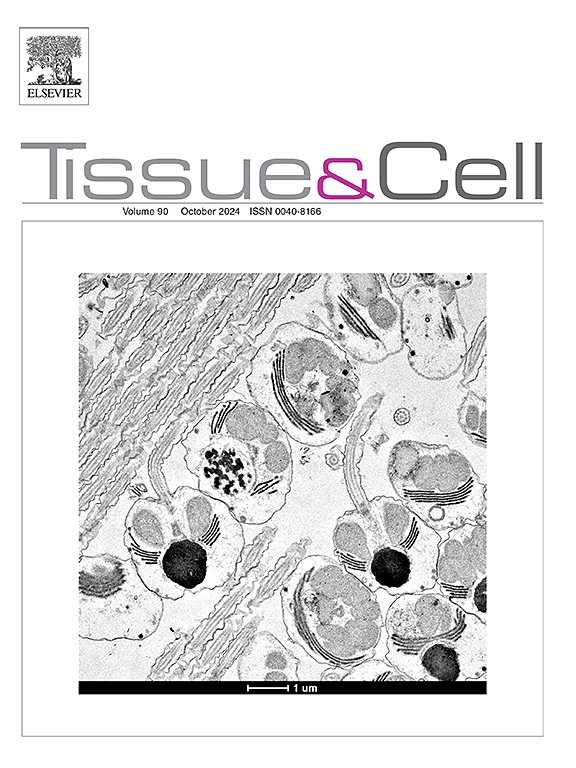Resolvin D5:一种脂质介质,通过SIRT6/自噬治疗肝脂肪变性
IF 2.7
4区 生物学
Q1 ANATOMY & MORPHOLOGY
引用次数: 0
摘要
Resolvin D5 (RD5)是一种由DHA通过5-脂氧合酶信号衍生的脂质介质,已被证明在多种疾病模型中解决炎症。本研究旨在探讨RD5在肥胖个体肝脂肪变性发展中的作用,并探讨其具体机制。蛋白表达通过Western blot分析,而肝脏脂质沉积通过油红O染色和甘油三酯定量检测。MDC染色检测自噬体。我们的研究结果表明,RD5治疗使棕榈酸处理的原代肝细胞的脂质积累、脂肪酸摄取、氧化、凋亡和内质网(ER)应激正常化。作为一种细胞保护信号通路,RD5处理增加了SIRT6和自噬标志物的表达,如参与LC3转化和p62降解的标志物。RD5对肝脏脂质代谢、细胞凋亡和内质网应激的有益作用被SIRT6小干扰RNA或3-甲基腺嘌呤(一种自噬抑制剂)所否定。此外,RD5可降低高脂饮食(HFD)喂养小鼠肝脏脂肪变性、细胞凋亡和内质网应激。与体外实验结果一致,RD5处理提高了hfd喂养小鼠肝脏中SIRT6和自噬水平。这些新发现表明,RD5通过SIRT6/自噬信号通路改善肝脏脂质代谢、细胞凋亡和内质网应激,从而减轻肝脏脂肪变性。RD5可能具有治疗副作用最小的非酒精性脂肪性肝病的治疗潜力。本文章由计算机程序翻译,如有差异,请以英文原文为准。
Resolvin D5: A lipid mediator with a therapeutic effect on hepatic steatosis through SIRT6/autophagy
Resolvin D5 (RD5), a lipid mediator derived from DHA via 5-lipoxygenase signaling, has been shown to resolve inflammation in various disease models. This study aimed to investigate the role of RD5 in the development of hepatic steatosis in individuals with obesity and explore the detailed mechanisms involved. Protein expression was evaluated via Western blot analysis, whereas hepatic lipid deposition was examined via Oil Red O staining and triglyceride quantification. Autophagosomes were detected via MDC staining. Our findings indicated that RD5 treatment normalized lipogenic lipid accumulation, fatty acid uptake, oxidation, apoptosis, and endoplasmic reticulum (ER) stress in palmitate-treated primary hepatocytes. As a cytoprotective signaling pathway, RD5 treatment increased the expression of SIRT6 and autophagy markers, such as those involved in LC3 conversion and p62 degradation. The beneficial effects of RD5 on hepatic lipid metabolism, apoptosis, and ER stress were negated by SIRT6 small interfering RNA or 3-methyladenine, an inhibitor of autophagy. Furthermore, RD5 administration decreased hepatic steatosis, apoptosis, and ER stress in the livers of high-fat diet (HFD)-fed mice. In line with the in vitro results, RD5 treatment elevated SIRT6 and autophagy levels in the livers of HFD-fed mice. These novel findings suggest that RD5 improves hepatic lipid metabolism, apoptosis and ER stress through SIRT6/autophagy signaling, thereby attenuating hepatic steatosis. RD5 may have therapeutic potential for treating nonalcoholic fatty liver disease with minimal side effects.
求助全文
通过发布文献求助,成功后即可免费获取论文全文。
去求助
来源期刊

Tissue & cell
医学-解剖学与形态学
CiteScore
3.90
自引率
0.00%
发文量
234
期刊介绍:
Tissue and Cell is devoted to original research on the organization of cells, subcellular and extracellular components at all levels, including the grouping and interrelations of cells in tissues and organs. The journal encourages submission of ultrastructural studies that provide novel insights into structure, function and physiology of cells and tissues, in health and disease. Bioengineering and stem cells studies focused on the description of morphological and/or histological data are also welcomed.
Studies investigating the effect of compounds and/or substances on structure of cells and tissues are generally outside the scope of this journal. For consideration, studies should contain a clear rationale on the use of (a) given substance(s), have a compelling morphological and structural focus and present novel incremental findings from previous literature.
 求助内容:
求助内容: 应助结果提醒方式:
应助结果提醒方式:


